In Texas, there are at least 100 species of snakes, but only 12 of them are poisonous. Snakes will emerge from their caves in late February or early March after “brumating” during the winter since they cannot tolerate temperatures below 32 degrees Fahrenheit. As a result, they typically confine their activity to the early morning, evening, and nighttime hours in hot places. Snakes are most active in the spring since the weather is warming up, and they are on the move in search of prey.
Snake Brumation Period In Texas
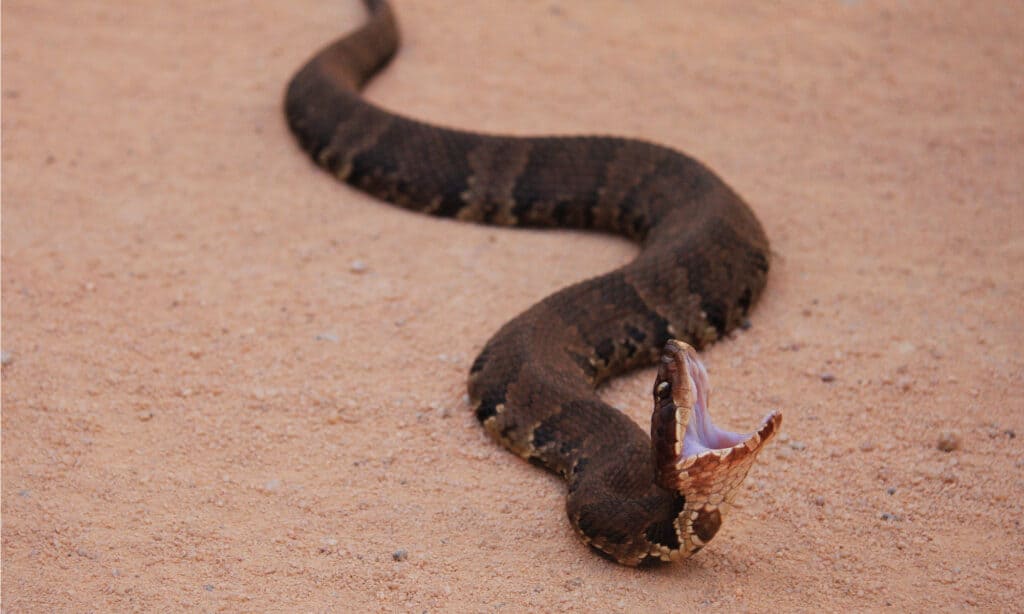
Snakes enter a brumation phase when temperatures are unbearable.
©Nathan A Shepard/Shutterstock.com
Even though snakes don’t hibernate, they wake up from “brumation.” Brumation occurs during the winter months when temperatures are below freezing. Cold weather causes snakes to become less active as their metabolism and core temperature both drop. As cold-blooded creatures, they are unable to control their body temperatures like mammals.
Snakes emerge from their caves in Texas as late as February or as early as March because of brumation. Their activity is restricted to early morning, evening, and nighttime in warmer places as well. In the months of September through December, brumation can occur and linger until March or April at the earliest. It’s hard to ignore the foreboding snakes when you’re in Texas, but they’re a crucial part of the environment here.
Most Active Periods for Snakes in Texas
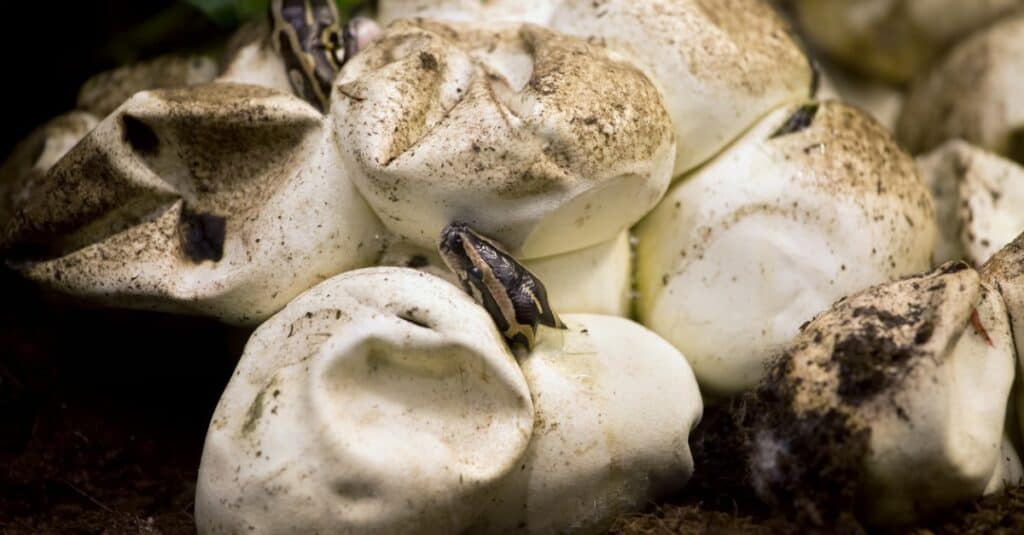
Some snake species give birth to live young, but many lay eggs.
©iStock.com/Artur Bogacki
Snakes love sunny, warm days. In Texas, they will be most active in the spring, summer, and fall and will be less active in the winter. They are particularly active from early spring through early summer, indicating that they are looking for food and mates. Late summer and early fall are still active months for snakes. Late summer and early fall are baby snake seasons when certain snake species give birth to live young.
Snakes To Be On The Lookout For In Texas
There are over 100 distinct species of snakes in Texas; 12 are venomous.
Here are the 12 snakes that are venomous and may be found in Texas:
- Eastern Copperhead
- Broad-banded Copperhead
- Northern Cottonmouth
- Western Diamondback Rattlesnake
- Timber Rattlesnake
- Rock Rattlesnake
- Black-tailed Rattlesnake
- Mojave Rattlesnake
- Prairie Rattlesnake
- Western Massasauga
- Western Pygmy Rattlesnake
- Texas Coral Snake
Let’s break down the four most venomous snakes in texas; coral snakes, copperheads, cottonmouths (water moccasins), and rattlesnakes.
Copperhead
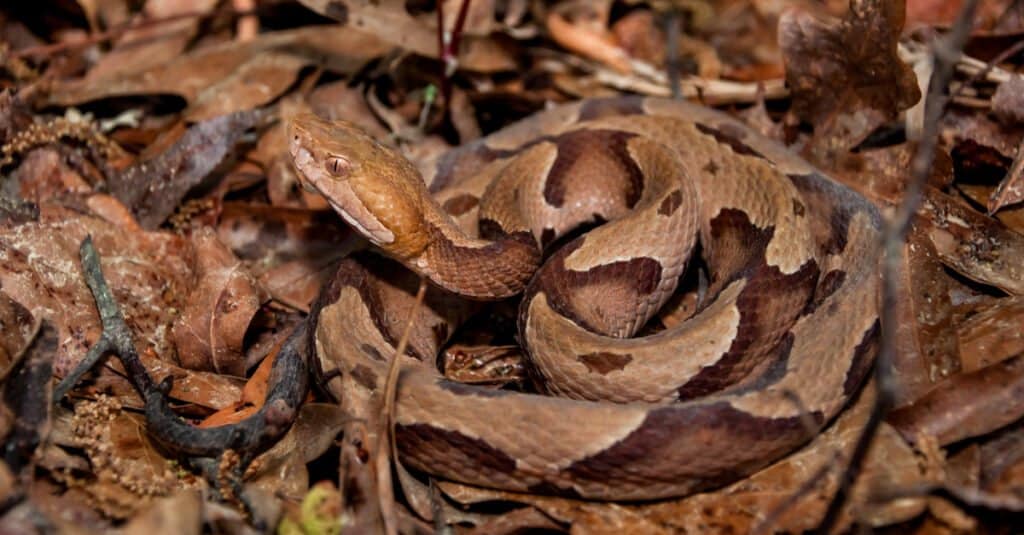
Copperheads have a coloring pattern that helps them blend in with dirt and leaves.
©Jay Ondreicka/Shutterstock.com
The southern copperhead is a common venomous snake in Texas. Copperheads are widespread across the state, although they are mostly spotted on land. Their tint helps them blend in with the foliage. They have a rusty color and hourglass design on their back that sets them apart.
These pit vipers feature gray, brown, or red crossbands and a gray, brown, or reddish head with brown or black stripes on the belly. Adults can reach 36 inches. Copperheads inhabit pine-hardwood forests, bottomland hardwood forests, rocky or brushy areas, and hillsides in Texas. These nocturnal hunters can be seen from April to November.
Texas Coral Snake
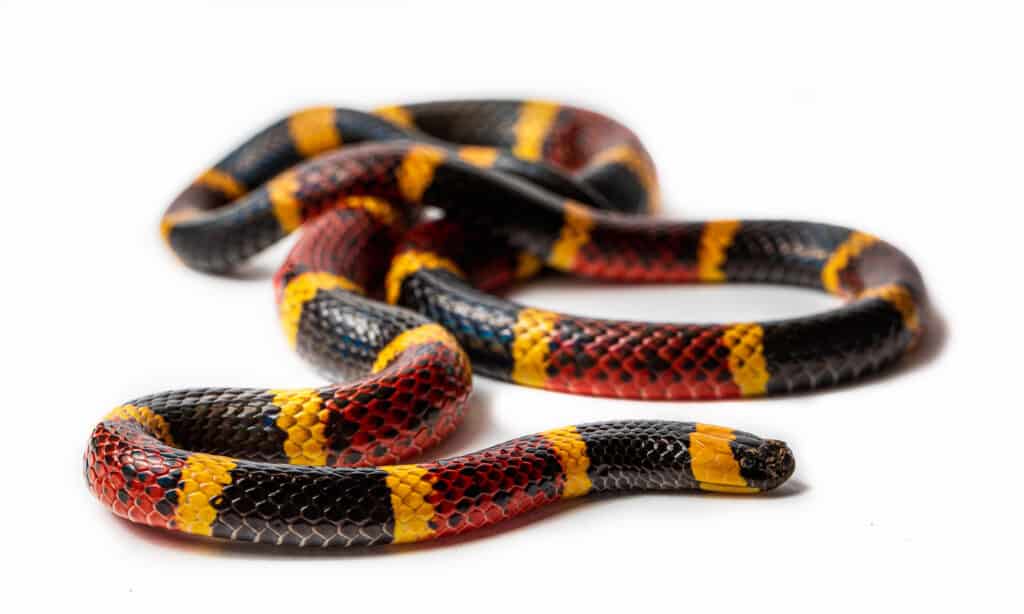
Texas coral snakes are known for their colorful banding of red, yellow, and black.
©Scott Delony/Shutterstock.com
The southern United States to northeastern and central Mexico are home to Texas coral snakes, making them quite prominent in Texas. Bright red, yellow, and black bands adorn their heads and bodies. Adult Texas coral snakes range in length from 51 to 76 cm (20-30 in), with the longest specimens being just under 121 cm (48 in).
Cottonmouth/Water Moccasin
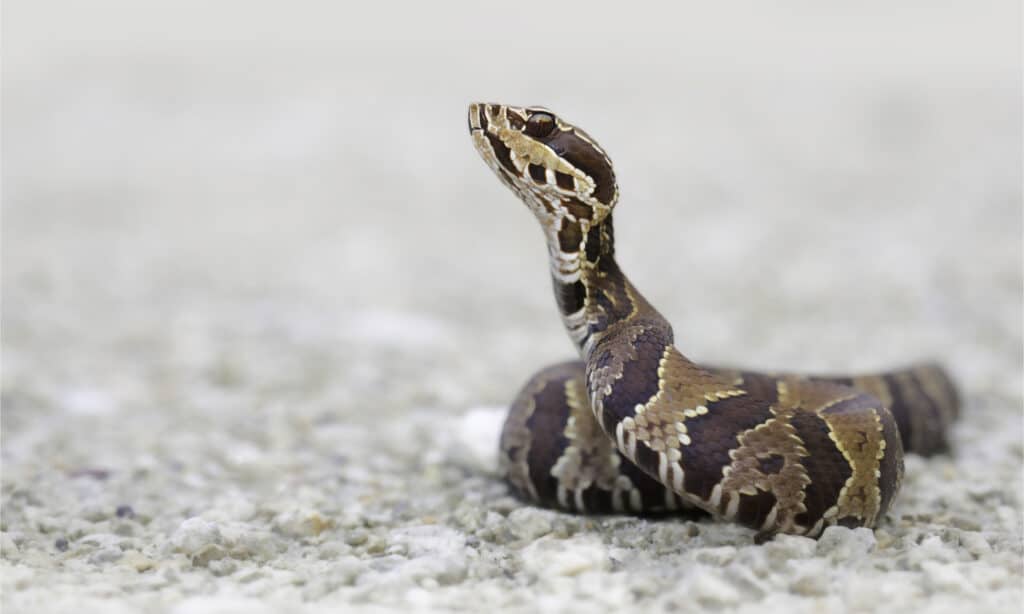
Cottonmouths are huge snakes with dark crossbands.
©Kristian Bell/Shutterstock.com
Cottonmouth snakes, often known as water moccasins, are huge semi-aquatic pit vipers native to Texas and the southern United States. These snakes have massive, blocky heads, while water snakes have flat or narrow heads. With keeled scales and an olive-brown to black appearance, these snakes are huge with dark crossbands.
Western Diamondback Rattlesnake

Western diamondback rattlesnakes coil up and rattle their tails to discourage predators.
©Audrey Snider-Bell/Shutterstock.com
Western diamondbacks are an endangered species in the United States but can be found in the state of Texas. These snakes grow from 36 to 60 inches long as adults. A bite from one can be harmful but not always deadly. However, untreated bites can cause serious health issues or even death.
Western diamondbacks are light brown to grayish brown in hue. With a pale border, they have 24–45 diamond-shaped brownish dots. They also have a white tail with 3-7 black stripes, and their adult size is 4 to 6 feet in length. Western diamondbacks have been observed swimming across water or climbing into trees to pursue prey. These rattlesnakes, like many others, hide in small caves or burrows.
Wrapping Up: When Do Snakes Come Out In Texas?
Whether poisonous or not, wild snakes should be avoided at all times of the year, night or day. Snakes are most active during spring and summer in the early morning hours when the soil temperature rises. It is common for snakes to go to sleep at night and wake up around dawn. Keep your distance from snakes, particularly if you’re unsure of what you’re getting yourself into. Contact a professional if it’s in your yard or property and you want it removed. Unless provoked, most venomous snakes will not strike. Snakes would often do whatever to avoid coming into contact with humans.
The photo featured at the top of this post is © Scott Delony/Shutterstock.com
Discover the "Monster" Snake 5X Bigger than an Anaconda
Every day A-Z Animals sends out some of the most incredible facts in the world from our free newsletter. Want to discover the 10 most beautiful snakes in the world, a "snake island" where you're never more than 3 feet from danger, or a "monster" snake 5X larger than an anaconda? Then sign up right now and you'll start receiving our daily newsletter absolutely free.
Thank you for reading! Have some feedback for us? Contact the AZ Animals editorial team.






